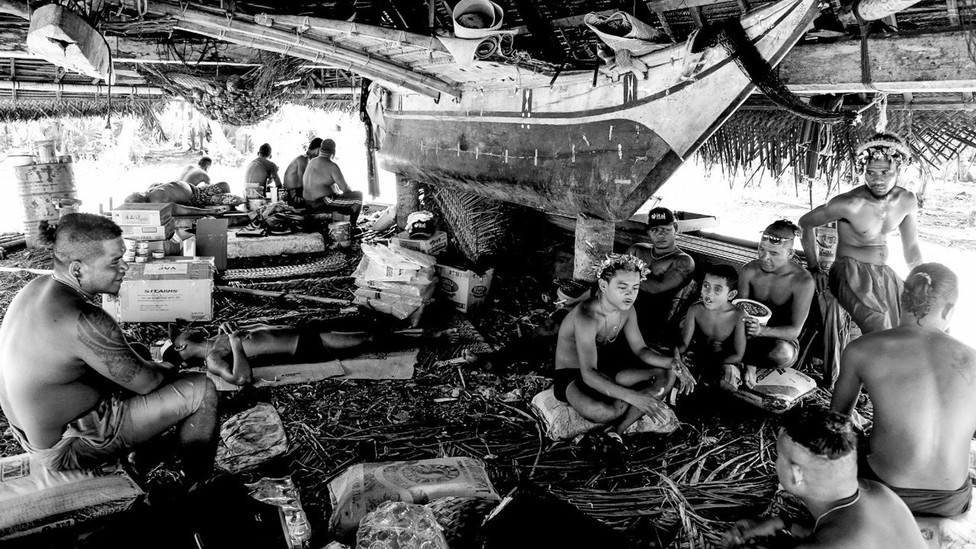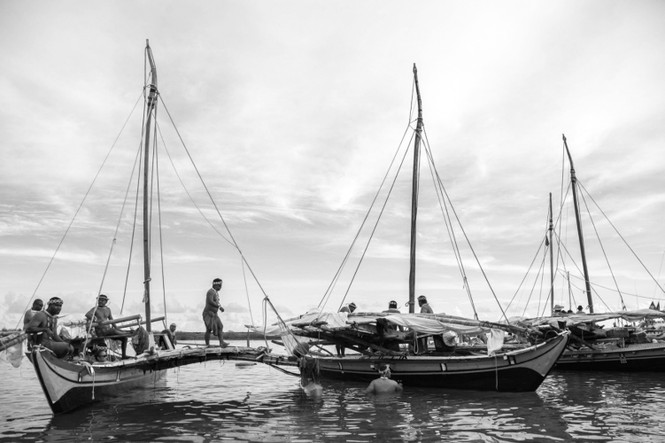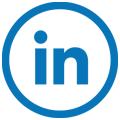Date: November 1, 2021
Link: https://www.theatlantic.com/culture/archive/2021/11/oceania-pacific-climate-change-stories/620570/

I know nothing of the night sky.
This saddens but does not surprise Larry Raigetal, a master navigator who is chewing betel nut beneath a canopy of stars. He is from Lamotrek, an outer island of Yap, in the Federated States of Micronesia. But we are meeting in a canoe house on the neighboring island of Guam, where I call home. As we speak, Raigetal is using his hands to split the horizon into a 32-point star compass. He is drawing on centuries of knowledge to explain to me the art of wayfinding—a method of non-instrument navigation that has been used by his people for thousands of years to voyage between the many atolls and islands of Micronesia.
To my surprise, the compass he is conceptually grafting onto the sky is more than a map of stars as they rise and fall from east to west across the horizon. Wayfinding is a manner of organizing an elaborate body of directional information collected and committed to memory by countless navigators before him and passed down through chants to his grandfather, to his father, to him. It’s a living repository of spectacularly specific details about sea swells, wind currents, reefs, shoals, and other seamarks—including living ones. A pod of pilot whales. A shark with special markings. A seabird.
As a Pacific Islander, I knew that the canoe house has long been a place of learning, and I’d come to ask Raigetal about whether wayfinding had been compromised by climate change. As a human-rights lawyer working at the intersection of indigenous rights and environmental justice, I’d also come because I believe that the peoples of the Pacific have important intellectual contributions to make to the global climate-justice movement. We have insights born not only of living in close harmony with the Earth but also of having survived so much already—the ravages of extractive industry, the experiments of nuclear powers. We have information vital to the project of recovering the planet’s life-support systems.
Finally, I’d come because my personal and professional reserves were depleted. Like so many others working in the climate space, I’d been feeling overwhelmed since August, when the Intergovernmental Panel on Climate Change released part of its sixth assessment report. The conclusions were bleak. Reading the report felt like being buried alive by an avalanche of facts—the facts of sea-level rise and progressively severe storms, among others—and I was looking to claw my way out.
As the darkness deepened around me and Raigetal, I realized two things. First, the climate-justice movement must listen more carefully to those most vulnerable to the ravages of climate change, such as Oceania’s frontline communities. Second, we who are waist-deep in that movement need more than facts to win. We need stories. And not just stories about the stakes, which we know are high, but stories about the places we call home. Stories about our own small corners of the Earth as we know them. As we love them.
In my corner, Micronesia, the facts are frightening. We are seeing a rate of sea-level rise two to three times the global average. Some scientists theorize that most of our low-lying coral-atoll nations may become uninhabitable as early as 2030. Faced with the prospect of climate-induced relocation, some leaders have contemplated buying land in other countries in anticipation of having to move some or all of their people.
One leader has already sealed a deal. In 2014, the then-president of Kiribati, Anote Tong, entered into a purchase agreement with the Anglican Church for more than 5,000 acres in Fiji, paying nearly $9 million for them. (Kiribati has since begun using the land for farming.) Though the deal was seen as visionary by some, to others it marked a kind of death. After all, at what point does an agreement that envisions the relocation of an entire human population—now some 121,000 people—become more eulogy than contract?
In Fiji, the government keeps its own kind of death list—an official record of all the villages that may have to be relocated because of sea-level rise. Using internal climate-vulnerability assessments, the Fijian government has determined which of its coastal villages are most susceptible to coastal erosion, flooding, and saltwater intrusion. As of 2017, 42 villages were on the list. If and when they are forced to move, they won’t be the first: In 2014, Vunidogoloa formally relocated to higher ground, some two kilometers inland.
When I spoke with Sailosi Ramatu, that village’s headman, in July, he told me the move was hardest on the elders. In the months leading up to the relocation, they held prayer circles. They fasted. They readied themselves for the rupture of having to abandon their ancestral lands. In Fiji (as in many of our islands), the people are tethered to the earth, as enshrined in the concept of vanua, a word that means “the land” and “the people” at once. Vunidogoloans live and love and die on their lands, most of which they do not even own, at least not as individuals. Rather, theirs is a system of communal land ownership. They tend to their gardens. They bury their dead. They even bury their umbilical cords. So it was no surprise when, as about 30 families set out for the new site, some of the older women wailed as they walked.
Perhaps that’s a sound the sea makes when it rises: old women wailing.
Not everyone made the journey; the dead remain interred in a cemetery at the old site. According to Ramatu, one of the biggest struggles his people faced was leaving their buried loved ones behind. Some worry they’ll be cursed for abandoning their deceased relatives. Others walk around with holes in their heart. Like the old man who visits the cemetery nearly every day to sit by the grave of his dead wife. I’m not sure which flowers he brings her, if any. But I imagine they’re beautiful.
erhaps the story of climate change is a story of flowers.
These are the facts in the Republic of the Marshall Islands (RMI), the country where the U.S. military houses its Ronald Reagan Ballistic Missile Defense Test Site: There, a crucial study on sea-level rise found that coral-atoll nations may not be able to sustain a human population past the present decade. This conclusion was met with trepidation by the Marshallese people I spoke with, who hear the ticking of the climate clock louder than most.
The 2018 study, led by the United States Geological Survey and commissioned by the Pentagon, focused exclusively on an island in the Kwajalein atoll that supports some 1,250 American military personnel, contractors, and civilians living there and on nearby islands. For the most part, the U.S. otherwise ignores this region. Wake Island, where an additional study on sea-level rise is now being done, is proof of that fact.
Wake, an island with no permanent inhabitants that the U.S. considers an unincorporated territory, is run by the Air Force under authority of a caretaker permit issued by the Interior Department. For its part, the RMI not only has a competing vision of what caretaking looks like; it also has a competing claim to Wake. In April 2016, the RMI formally claimed Wake Island when it filed its maritime coordinates with the United Nations secretary-general.
The truth is that neither government is entirely correct. The strongest claim is that of the Marshallese people themselves, who say the island is theirs by way of history, culture, and birthright, and who long to be able to take proper care of it. They also say that Wake is not the island’s true name.
Its true name is Enen-Kio. The island of the orange flower.
Famous in lore for the beauty of these flowers, Enen-Kio is also known for its rare assemblage of nesting seabirds—frigates and albatross, among others. Legend has it that local warriors, seeking to prove their worthiness, would journey to the island in search of the wing bones of one such seabird. Fourteen years ago, on another starry night, a high chief explained to me that the retrieved bones were used as chisels in traditional tattoo ceremonies.
I did not grasp the significance of the strip of orange splayed across the RMI flag until much later. Former President Hilda Heine would tell her poet daughter, Kathy, who would tell me: For the Marshallese, orange is the color of bravery.

On my island, climate change is a story of storms. Guam—the largest and southernmost of the Mariana Islands and an unincorporated territory of the U.S.—lies within one of the most active regions for tropical cyclones in the world. The typhoons that have historically battered the island are so strong, they’re often called “super typhoons.”
Everyone here remembers their first. Mine was Omar, in August 1992. We were unprepared—my mother, brother, sister, and me. This was in part because my father, who typically did the preparatory work of putting up shutters and removing debris from around the house, had recently died. I remember the four of us huddled behind a cream-colored mattress. I remember tracing its embroidered flowers with my finger.
I remember everything, really. Trees and telephone poles cracked in half. The roof of our neighbor’s house went flying, as did his canopy and one of his cars. I remember glass everywhere, as several windows and a sliding door shattered. I remember the sound of the wind as it blew under the bottom of my bedroom door. Like an old man sucking his teeth.
Pamela is the one my mom remembers. May 1976. One of the most intense storms to strike Guam last century, Pamela generated eight-meter waves and ravaged the beaches on both the northern and eastern sides of the island. She sank 10 ships in the local harbor. She did an estimated $500 million worth of damage. But none of this is what my mom remembers. What she remembers, what she will never forget, is a single white toilet. American Standard. The one thing left of her house when Pamela was over.
Then there was Paka. December 1997. The wind and rain beat down on us for 12 hours. The barometric pressure was so low that it was believed to have induced labor in nine pregnant women. Paka, like Russ in 1990 and Yuri in 1991, unearthed untold numbers of dead bodies when it slammed into the southern cemeteries of Yona and Inarajan. Corpses spilled out of their coffins. Coffins bobbed like buoys in the bay.
Several families spent weeks combing the beaches in search of their loved ones. Some were never found. My aunt, who worked for one of the cemeteries, said that one family was able to identify their father’s body only because of a cherished baseball cap, which they had buried him in and which had stuck to his skull by way of a mess of seaweed. Suffice it to say, when the IPCC dropped its latest report, confirming that tropical cyclones are just going to get stronger, my corner of the world shuddered.
After all, although 1.5 degrees Celsius of warming will make these storms even more severe, that same severity will increase dramatically with 2 degrees Celsius, let alone 3. I can’t begin to imagine what any of this will mean on the ground—and not just for Guam or the Northern Mariana Islands, but for Vanuatu, Fiji, and Solomon Islands, whose communities already seem to be lurching from one Category 5 cyclone to another.

Throughout oceania, the story of climate change is also a story of ingenuity. In the Carteret Islands—off the coast of Bougainville, in Papua New Guinea—the women are taking matters into their own hands. Frustrated by how slowly the Papua New Guinean government was implementing its relocation plans, they sought to mobilize the community around the issue of relocation. They formed an organization and named it Tulele Peisa, which means “sailing the waves on our own” in the local Halia language.
To date, Tulele Peisa has organized several community consultations as well as visiting missions between the Carteret Islanders and potential host communities in nearby Bougainville. According to Ursula Rakova, the group’s leader, Tulele Peisa has also secured several tracts of arable land on which it is now growing gardens of taro and cassava. She told me the group has planted more than 30,000 cocoa trees and even established a cocoa-bean refinery. All told, Tulele Peisa has developed an 18-point relocation plan for its community. Rakova said other coastal communities have followed suit and are currently formulating their own relocation plans.
So it would seem that the Pacific Climate Warriors were right. The youth-led group fighting climate change across Oceania, as part of the global 350.org network, famously declared: We’re not drowning. We’re fighting.
And we are.
The Marshall Islands has spearheaded the Climate Vulnerable Forum, a group of 48 countries that works to amplify voices that have long been marginalized in the climate realm. Fiji, too, has taken a leadership role, presiding over the Conference of the Parties for the 23rd United Nations Framework Convention on Climate Change and spearheading the so-called talanoa dialogues—sessions that use storytelling to foster more empathetic decision making.
One could argue that Fiji is also leading the way on the complex issue of climate-induced relocation. Consider the list of 42 villages slated for possible relocation. However heartrending, the very existence of the list is a testament to Fiji’s efforts. Conversations about relocation are enormously difficult to have, but that country is having them.
Tuvalu, Tokelau, Kiribati, and the Marshall Islands have joined forces with the Maldives to form a coalition of coral-atoll nations to advocate for the financial resources necessary to adapt to climate change. To date, what money most of them have been able to secure has been limited to funding the first-generation stuff of seawalls and early-warning systems—nowhere near the level they will need to actually adapt, let alone adapt in place. But they press on, planting mangroves and plugging away at their national plans.
A group of law students from the University of the South Pacific led a different charge in Vanuatu: They advocated that that climate-vulnerable country take the lead in pursuing an advisory opinion on climate change from the International Court of Justice. As these students see it, the lack of clarity around state duties is impairing the collective efforts of the international community to respond effectively to the climate crisis. In September, the students succeeded in their initial goal, and Vanuatu announced that it would spearhead the initiative. (I should note here that I am leading the global team assisting Vanuatu in this effort.)
In the Marianas, many indigenous Chamorros and Carolinians of Guam and the Commonwealth of the Northern Mariana Islands are fighting the destruction of our lands and seas by the single largest institutional producer of greenhouse gases in the world: the U.S. military. On land, these activists are opposing the construction of a massive firing range, which they say will destroy a limestone forest and imperil a whole host of nonhuman life. At sea, they’re challenging the Defense Department’s attempt to militarize a section of the ocean almost the size of India.
All this to say, if my corner of the Earth had an anthem, it’d be this: To hell with drowning.
That anthem was never more clearly on display than during the 12th Festival of Pacific Arts, held in the summer of 2016, when the Lucky Star arrived at the local harbor. Lucky Star was one of three canoes sailed to Guam from Lamotrek by the wayfinder Raigetal and his crew of apprentices. What made this particular canoe so special was the fact that its sail was traditional, meaning it was woven from pandanus leaves by the women of Lamotrek.
There, in the weeks leading up to the voyage, it was discovered that the knowledge of how to weave such a sail was very nearly lost. Literally one woman still knew how to do it.
Her name was Maria Labushoilam, a 90-year-old master weaver, and she was dying.
Maria would spend the last two weeks of her life teaching 15 women how to make that sail. From her deathbed, she taught them how to harvest, dry, and split the leaves, and then how to weave them. After she died, the women completed the sail without her. The community raised it together.
The Lamotrekese are emblematic of the predicament all Oceanic peoples are facing today: We come from cultural traditions rich in beauty and resilience—the same traditions that have enabled us to thrive in our ancestral spaces for thousands of years—but that is simply not enough to ensure our continued survival. The part simply cannot save the whole. The answer to the question of climate change must come from everyone, or it will come from no one.
You could say Maria performed something of a miracle in her final days. With nothing more than pandanus leaves and love, she opened a window to a world—a future in which good people refuse to simply lie down and die, a future rooted in respect for possibility, a future with room for us all.
May we have the courage to climb through it.






